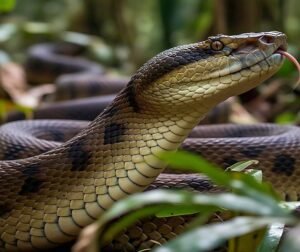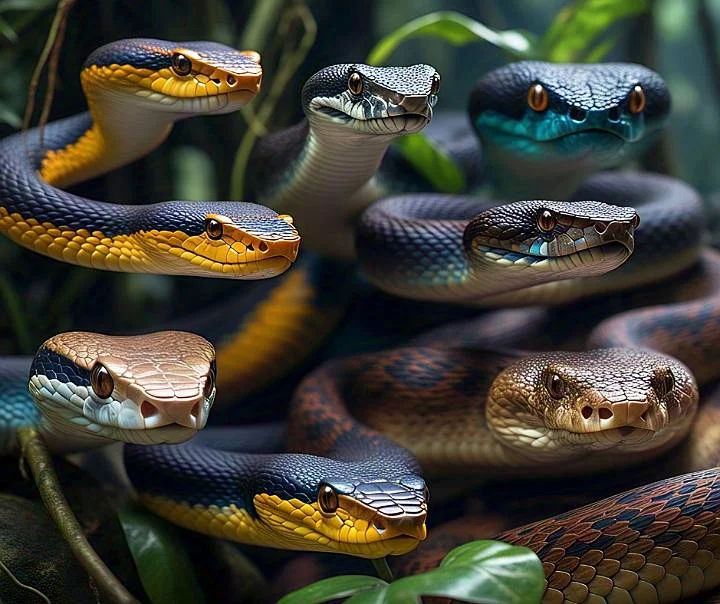The Giant amazon anaconda snake of the Amazon : Life Cycle, Characteristics, and Mysterious World
The Amazon rainforest, often referred to as the largest and most biodiverse jungle on Earth, is home to a plethora of unique and awe-inspiring creatures. Among these is the Green Anaconda (Eunectes murinus), recognized as the world’s heaviest and second-longest snake. Renowned for its immense size, strength, and enigmatic lifestyle, the green anaconda captivates researchers and wildlife enthusiasts alike. In this comprehensive blog post, we will delve into the life cycle, characteristics, behavior, diet, reproduction, and ecological significance of the amazon green anaconda snake.
Amazon anaconda snake: An Introduction
The amazon green anaconda snake, also known as the common anaconda, giant anaconda, or southern green anaconda, is native to the tropical regions of South America. Belonging to the Boidae family, it is a non-venomous constrictor snake. Its massive size and strength make it an apex predator in its ecosystem. The scientific name Eunectes murinus derives from the Greek word Eunectes, meaning “good swimmer,” reflecting its semi-aquatic lifestyle.
- Size: On average, green anacondas measure 4.6 meters (15 feet) in length, but females can grow up to 9 meters (29.5 feet) and weigh as much as 250 kilograms (550 pounds). Females are significantly larger than males. National Geographic
- Color and Pattern: The snake’s body is olive-green with black oval spots. Orange-yellow stripes on the head aid in camouflage while submerged in water. Wikipedia
- Habitat: amazon anaconda snake primarily inhabit the Amazon River Basin, Orinoco Basin, and the Llanos grasslands of Venezuela. They thrive in slow-moving rivers, lakes, and swampy areas. Smithsonian National Zoo
Amazon Anaconda Snake Life Cycle: From Birth to Adulthood
The life cycle of the green anaconda is divided into several stages, each showcasing its growth, reproduction, and adaptation to its environment. Let’s explore each phase in detail.

1. Birth and Neonatal Stage
- Birth Process: Green anacondas are ovoviviparous, meaning the female retains eggs inside her body, giving birth to live young after a seven-month gestation period. A female typically produces 20–40 offspring, though litters of up to 82 have been recorded. Smithsonian National Zoo
- Neonate Size: At birth, baby anacondas measure approximately 68 centimeters (27 inches) in length and weigh around 200 grams. These neonates are independent from birth and receive no parental care. Animal Diversity Web
- Early Behavior: Newborn anacondas begin swimming and hunting immediately. They prey on small fish, frogs, and insects, employing an ambush strategy to capture food.
2. Juvenile Stage
- Growth: In the first few years after birth, Amazon green anacondas snake grow rapidly, potentially increasing their body weight by up to 500 times. Animal Diversity Web
- Diet: Juvenile anacondas feed on fish, birds, and small mammals. Their hunting strategy involves hiding in water to ambush prey, facilitated by eyes and nostrils positioned on the top of their heads, allowing them to remain almost fully submerged. National Geographic
- Threats: During this stage, they are vulnerable to predators such as caimans, jaguars, and large birds. However, their camouflaged skin helps them evade detection.
3. Adulthood
- Sexual Maturity: Green anacondas reach sexual maturity at 3–4 years of age. By this time, females are significantly larger than males. Smithsonian National Zoo
- Size and Strength: Adult females can grow 6–9 meters long and weigh 200–250 kilograms, while males average around 3 meters. Their powerful muscles enable them to subdue large prey, including deer, caimans, and even jaguars. Britannica
- Lifespan: In the wild, their average lifespan is around 10 years, but in captivity, they can live for 20–30 years. Smithsonian National Zoo
4. Reproductive Stage
- Breeding Season: Green anacondas breed primarily between March and May during the dry season. Smithsonian National Zoo
- Breeding Behavior: Green anacondas are polyandrous, with one female mating with multiple males. Males form a “breeding ball” around a female, where 2–13 males compete for mating rights. This process can last for weeks. Animal Diversity Web
- Cannibalism: In some cases, females may consume smaller males after mating, as they do not feed during gestation. Britannica
- Energy Cost: Reproduction is energy-intensive, so females typically breed every other year to recover their energy reserves.
5. Old Age and Death
- Old Age: As anacondas age, their physical activity slows down. Larger females face fewer threats from predators, but males remain more vulnerable.
- Causes of Death: In the wild, anacondas may die from natural causes, predation, or human activities such as habitat destruction. The recent death of a giant anaconda named “Ana Julia,” possibly shot, highlighted concerns about biodiversity loss. NDTV
Characteristics and Adaptations
The green anaconda’s unique physical characteristics and adaptations make it a formidable predator. Here are some key features:
- Physical Structure:
- Eyes and Nostrils: Positioned on the top of the head, these allow the anaconda to remain submerged while stalking prey. Wikipedia
- Jaws: Loose ligaments connect the jaws, enabling them to swallow prey larger than their heads. National Geographic
- Skin: The loose, flexible skin absorbs water and aids in swallowing large prey. Live Science
- Constriction: As non-venomous snakes, anacondas constrict their prey, using powerful muscles to suffocate it. Their strength can even crush bones. Kids National Geographic
- Digestion: After swallowing prey, digestion can take several days, during which the anaconda becomes sluggish. The liver, its largest organ, plays a crucial role in digestion. Wikipedia
- Swimming: Known as “good swimmers,” anacondas are agile in water but slow on land. Live Science
Diet and Hunting Strategies
The green anaconda is an opportunistic apex predator, consuming a wide variety of animals depending on its age and size.
- Juvenile Anacondas: Feed on fish, frogs, small birds, and small mammals.
- Adult Anacondas: Prey on larger animals such as caimans, deer, capybaras, tapirs, and large birds. In rare cases, they can kill jaguars and small crocodiles. Smithsonian National Zoo
- Human Attacks: Though rare, their size makes them capable of consuming humans. National Geographic
- Hunting Strategies:
- Ambush: Anacondas hide in water or dense vegetation, waiting for prey to approach.
- Constriction: They wrap their muscular bodies around prey, constricting until the prey suffocates.
- Swallowing: Their ability to swallow prey whole is enabled by loose jaws and flexible skin.
- Digestion and Metabolism: Anacondas have a slow metabolism, allowing them to survive weeks without food. During gestation, females may fast for months. Wikipedia
Habitat and Distribution
The green anaconda is found across tropical South America. Its primary habitats include:
- Geographic Distribution:
- Amazon River Basin (Brazil)
- Orinoco Basin (Colombia)
- Llanos Grasslands (Venezuela)
- Other countries: Ecuador, Peru, Bolivia, Guyana, Paraguay, French Guiana, and Trinidad. Smithsonian National Zoo
- Preferred Habitat:
- Slow-moving rivers, lakes, and swamps.
- The green anaconda, the largest and heaviest snake species, is a semi-aquatic boa found in South America and the Caribbean island of Trinidad. It is the heaviest snake globally, surpassed in length only slightly by the reticulated python. Wikipedia
- Seasonal Adaptations: During the wet season, they disperse into flooded areas, while in the dry season, they seek deep pools or burrow into mud to stay hydrated. Smithsonian National Zoo
Conservation and Threats
The green anaconda is currently listed as “Least Concern” on the IUCN Red List, but it faces several threats:
- Habitat Loss: Deforestation and agricultural expansion in the Amazon threaten its habitat. Smithsonian National Zoo
- Human Activities: Illegal hunting, poaching for skins, and human-wildlife conflict impact its survival.
- Invasive Species: In some regions, like Florida, green anacondas are considered invasive, as they can disrupt local ecosystems. National Geographic
- Conservation Efforts:
- Establishment of protected areas, such as national parks in the Amazon.
- Bans on illegal hunting and awareness campaigns.
- Research: Scientists like Dr. Jesús Rivas are studying anaconda biology and conservation. Wikipedia
Cultural and Mythological Significance
The green anaconda holds a significant place in South American cultures:
- Mythology: Many indigenous communities view it as a creator of water or a spiritual entity. Live Science
- Popular Culture: In films (e.g., Anaconda 1997), comics, and adventure stories, anacondas are portrayed as dangerous creatures, fueling myths about them. Wikipedia
- Scientific Interest: The recent discovery of a new species, the northern green anaconda (Eunectes akayima), has drawn global attention. BBC Newsround
Size Myths and Reality
The green anaconda’s size has made it the subject of numerous myths:
- Myth: Some claims suggest anacondas can grow 12–15 meters long, but no scientific evidence supports this. Wikipedia
- Reality: The largest verified specimens measure 6.3 meters and weigh 440 pounds, like “Ana Julia.” NDTV
- Guinness Record: Anacondas are considered the most mythologized creature due to size exaggerations. Wikipedia
Conclusion
The amazon anaconda snake is not only celebrated for its size and strength but also plays a vital role in the biodiversity and ecosystem of the Amazon rainforest. Its life cycle, from birth to adulthood, exemplifies nature’s remarkable adaptations and survival strategies. However, habitat loss and human activities pose significant threats to its future. Raising awareness and protecting its habitat are crucial for conserving this extraordinary species.
Would you like to learn more about the green anaconda? Share your thoughts in the comments, and spread the word by sharing this blog to help others discover the mysterious world of this giant snake!
